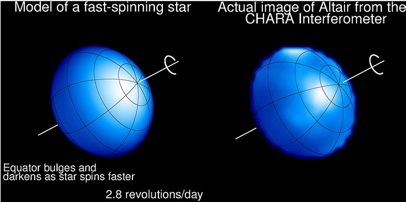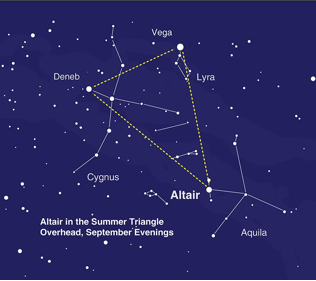Altair is the final stop on our trip around the Summer Triangle! The last star in the asterism to rise for Northern Hemisphere observers before summer begins, brilliant Altair is high overhead at sunset at the end of the season in September. Altair might be the most unusual of the three stars of the Triangle, due to its great speed: this star spins so rapidly that it appears “squished.”
A very bright star, Altair has its own notable place in the mythologies of cultures around the world. As discussed in our previous edition, Altair represents the cowherd Niulang in the ancient Chinese tale of the “Cowherd and the Weaver Girl.” Altair is the brightest star in the constellation of Aquila the Eagle; while described as part of an eagle by ancient peoples around the Mediterranean, it was also seen as part of an eagle by the Koori people in Australia! They saw the star itself as representing a wedge-tailed eagle, and two nearby stars as his wives, a pair of black swans. More recently one of the first home computers was named after the star: the Altair 8800.
Altair’s rapid spinning was first detected in the 1960s. The close observations that followed tested the limits of technology available to astronomers, eventually resulting in direct images of the star’s shape and surface by using a technique called interferometry, which combines the light from two or more instruments to produce a single image. Predictions about how the surface of a rapidly spinning massive star would appear held true to the observations; models predicted a squashed, almost “pumpkin-like” shape instead of a round sphere, along with a dimming effect along the widened equator, and the observations confirmed this! This equatorial dimming is due to a phenomenon called gravity darkening. Altair is wider at the equator than it is at the poles due to centrifugal force, resulting in the star’s mass bulging outwards at the equator. This results in the denser poles of the star being hotter and brighter, and the less dense equator being cooler and therefore dimmer. This doesn’t mean that the equator of Altair or other rapidly spinning stars are actually dark, but rather that the equator is dark in comparison to the poles; this is similar in a sense to sunspots. If you were to observe a sunspot on its own, it would appear blindingly bright, but it is cooler than the surrounding plasma in the Sun and so appears dark in contrast.
As summer winds down, you can still take a Trip Around the Summer Triangle with this activity from the Night Sky Network. Mark some of the sights in and around the Summer Triangle at: bit.ly/TriangleTrip. You can discover more about NASA’s observations of Altair and other fast and furious stars at nasa.gov.
The image on the right was created using optical interferometry: the light from four telescopes was combined to produce this image of Altair’s surface. Image credit: Ming Zhao. More info: bit.ly/altairvsmodel
Altair is up high in the early evening in September. Note Altair’s two bright “companions” on either side of the star. Can you imagine them as a formation of an eagle and two swans, like the Koori?
This article is distributed by NASA Night Sky Network
The Night Sky Network program supports astronomy clubs across the USA dedicated to astronomy outreach. Visit nightsky.jpl.nasa.gov to find local clubs, events, and more!



